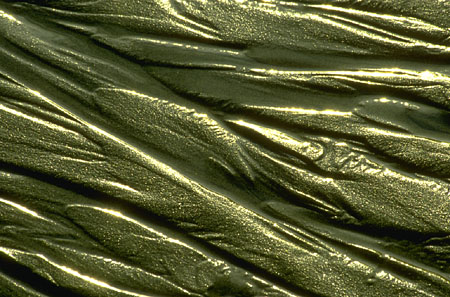LITR 5535: American
Romanticism

Sample Student Midterm 2006
Curtisha Wallace
October 5, 2006
Gothic Wilderness: An Analogy to American Experience
“It became, emphatically, the bloody arena, in which
most of the battles for the mastery of the colonies were contested.”
In war, armies use the wilderness as a “cover” in order to gain ground and surprise their enemy. Those who are unfamiliar with the wilderness find themselves submitting to its fortitude. The “darkness” of the armies, blood shed, colors (white/dark and red/yellow) and decay turn this scene into a gothic land.
“The Last of the Mohicans,” is set during the French and Indian wars. Gothic images in this novel seem to be in direct relation to the American experience. What makes “The Last of the Mohicans” different from the other texts is its representation as “a true gothic romance: gothic characters surrounded by a gothic space, both unique to America” (Gooding).
In “The Last of the Mohicans,” Cooper compares the forests to a grave. “… armies larger than those that had often disposed of the sceptres of the mother countries, were seen to bury themselves in these forests, whence they rarely returned but in skeleton bands, that were haggard with care, or dejected by defeat.” When armies enter into the forests they look as if they are swallowed into its confines because of the forests immensity. Once inside, the armies camouflage themselves to their surroundings in order to have an advantage over their enemies. Unfortunately, in this type of conflict, few soldiers return. Bury in this text can thus be an analogy to the camouflaging. It can also be a reference to the soldiers that have fallen, their corpses scattering the ground, turning the land into a burial site. Skeleton bands describe the number of soldiers who returned from war; but may be ghosts who rove the land.
These gothic images are a replication of the American experience during war. Soldiers leave to enter a world that is “unknown” or “feared” by Americans. Everyone becomes anxious because they are aware of the repercussions of war, yet they know that if no one defends what is right, their world would possibly be subjected to tyranny. “…the blood of the timid curdled with terror, and mothers cast anxious glances even at those children which slumbered within the security of the largest towns.” Often, the battleground becomes a site where loved ones fall to their death. Those who return are worn-out and some experience post-traumatic stress.
Cooper creates sounds that frighten the travelers and includes calculated yet unsuspecting movements that draw the reader into the physical space of the forests. However, his imagery is consistent with the things that cause the skin on the nape of Americans’ necks to rise. Horses cry in the night as they are surrounded by wolves. Silence penetrates the forests at awkward moments. War cries are shouted from enemies. Gun shots ring through the air. Branches are moved aside exposing visages of a seemingly unknown predator.
Gothic Indians. Cooper refers to them throughout the text as “beasts of prey with horrid visages; darkly painted lineaments; as fiercely wild as savage art and unbridled passions.” These descriptions along with the conversations and body language expressed among the travelers parallel how Americans felt about Indians. Conversations in this novel reveal that Indians were feared because of their aggressiveness and brutal practices. They were not viewed as human-beings because of their savage-like qualities. Thus, everything they did was considered “dark.”
From the Indian’s perspective, though, Americans were seen as the ones that were gothic. Chingachcook, inspired through an ancestral story, reminds Hawkeye that the white man was the one who came in and took Indian land by force using guns haphazardly. Yet, later on in the text, Cooper thwarts this idea with disturbing images: Magua taking a baby out of a woman’s arms and smashing it on a rock and Magua drinking blood.
The drinking of blood in today’s society is usually associated with vampires and portrayed as something bestial. It is often written in horror books and screened in horror movies. However, there are groups throughout our nation that consider themselves to be gothic: figures that stand-out in the crowd with their black hair, black eyeliner, black fingernail polish, black clothing. These groups are treated like the Indians. Outcasts. People fear them because they are often connected to satanic acts. Human sacrifices.
Mary Rowlandson also portrays the Indians as “ravenous beasts.” Her story is different in that it focuses more on her experiences while in captivity. So, lots of imagery is used to describe the unethical practices of the Indians while she was in their company. One of the most vivid is her point of view of an Indian celebration. “Oh the roaring, and singing and dancing, and yelling of those black creatures in the night, which made the place a lively resemblance of hell.” Here the Indians are compared to demons: black creatures. Rowlandson uses the color black to draw on the reader’s perceptions to that of a creature that is evil and void of emotion; something that is starving for power and does anything to get it. Thinking about Indian rituals, the reader believes this analogy because of the things that are common to this tradition: Indians circled around a great fire at night, singing, dancing, and chanting, painted from head to toe, enjoying a feast to feed more than its inhabitants. Though Rowlandson viewed her situation as gothic, she does not go into great detail about the wilderness that she mentions sporadically throughout the text.
Washington Irving takes another approach to the gothic: tales, legends that include stories of ghosts and goblins. “Sleepy Hollow” is a legend of the headless horseman who roamed the wilderness. Tales were often told about this ghost among the neighbors of Sleepy Hollow. Ichabod, the main character in this tale, comes to his face to face with his fate after an encounter with the headless horseman. Irving plays on the word “black” suggesting lurking danger. He uses imagery common to descriptions of terror “the hair…rose upon his head with terror;” “gathered up in the gloom like some gigantic monster ready to spring upon the traveler.” Irving even refers to the ghost as a goblin implying that the creature has intentions in causing him harm. This is the classic scary story; one that is told around Halloween because of its supernatural gothic qualities. “It is a favorite story often told about the neighborhood round the winter evening fire.”
Irving treats the gothic as that that exists outside the realm of human experience by changing it to a ghost story. Rowlandson draws on personal experience of captivity, thus bringing the crudeness of the Indian culture to the forefront. These texts converge in “The Last of the Mohicans”. Some of the Indians are given goblin like qualities i.e. Magua whose sole intent is to harm the travelers; thereby seeking revenge on the captain of the army who he feels has betrayed him. Stories about Indians and whites, like the stories of the headless horseman, are passed down from generation to generation within this text. Images of black, dark, evil, decay splatter the pages as Rowlandson’s experiences are verified in Cooper’s story through ravenous beasts like the Hurons led by Magua. Though the experiences are not identical, they are similar. Cooper brings it home by comparing the gothic to that of warring armies: French and Indians.
|
|
|
|


